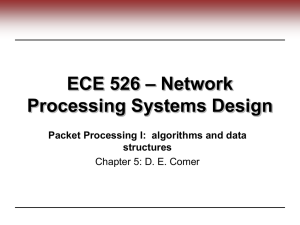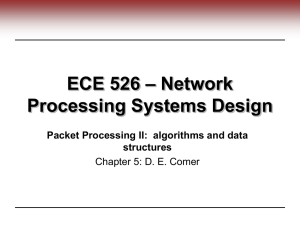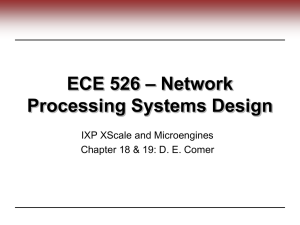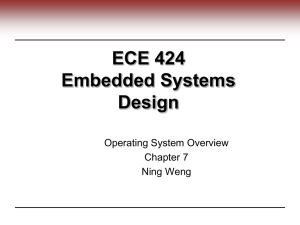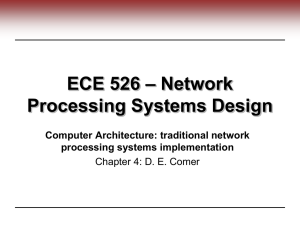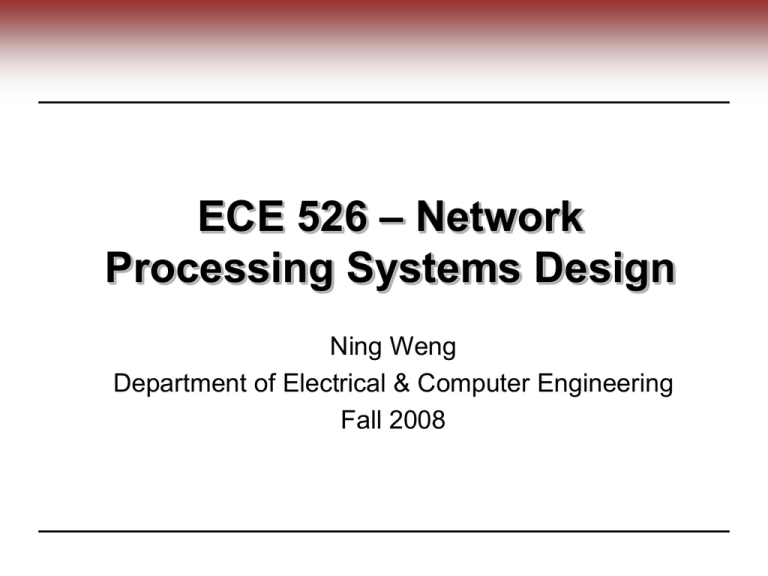
ECE 526 – Network
Processing Systems Design
Ning Weng
Department of Electrical & Computer Engineering
Fall 2008
Welcome Aboard
• Who am I?
─ Ning Weng, Assistant Professor in ECE
─ Office: Engineering E119
─ Email: weng@engr.siu.edu
• Research interests:
─
─
─
─
Network processor
System integration
Analytical performance modeling
Network system security
• Tell us who you are
─ In one semester
Ning Weng
ECE 526
2
What is the Internet?
Ning Weng
ECE 526
3
World Wide Web
Ning Weng
ECE 526
4
Application View: Google
Ning Weng
ECE 526
5
Application View: Others
IP picture frame
http://www.ceiva.com/
Web-enabled toaster +
weather forecaster
• Other examples:
─
─
─
─
─
─
─
Email
File Transfer
Firewall
IP Phone
Virtual Private Network (VPN)
E-commerce
Games
Ning Weng
ECE 526
6
Abstract View: in the Beginning
• The first 2 nodes on the
ARPANET
─ IMP:
• Interface Message
Processors
• Network manager
• Evolved to today’s
router
─ Client Server Model
Ning Weng
ECE 526
7
Abstract View: UUNET
Ning Weng
ECE 526
8
Nuts and Bolts View
• Millions of connected
computing devices
─
─
─
─
router
Running network applications
Client, server
Protocol, service
Host, end node
server
workstation
mobile
local ISP
• Network processing systems
─
─
─
─
Inside the network
Example: router, switch
Throughput
latency
regional ISP
• Communication links
─ fiber, copper, radio, satellite
─ bandwidth
Ning Weng
company
network
ECE 526
9
What is the Internet: Summary
• Communication infrastructure enables distributed
applications
• Computational architecture that client requesting service
from server
• A system of interconnected of processing systems
─ Links
─ End nodes
─ Network processing systems
• What is the network processing system?
Ning Weng
ECE 526
10
What is Network Processing Systems?
• Integral part of the Internet
• Network processing system determine the properties of
the Internet
─
─
─
─
Functionality
Performance
Reliability
Security
• The key requirement
─
─
─
─
Performance
Flexibility
Scalability
Ease of use
Ning Weng
ECE 526
11
Router
Router
packets
Port
Port
Switching fabric
Port
Ning Weng
Port
ECE 526
12
Network Processor
Network Processor
Processor Core
Processor Core
Co-processor
Processor Core
Processor Core
Interconnect
Network Interface
Processor Core
Co-processor
I/O
Ning Weng
ECE 526
13
Network Processor Based Router
Router
Port
packets
Port
Switching fabric
Router Port
Processor
Core
Processor
Core
Processor
Core
Coprocessor
Processor
Core
Port
Port
Processor
Core
Interconnect
Network Interface
Network Processor
Coprocessor
I/O
Ning Weng
ECE 526
14
What is the Course About?
─ Network Processing System Design
•
•
•
•
What is the minimal set of functionality?
How to implement them efficiently?
What is the optimal system architecture?
How to design a system architecture scalable to next generation
networks?
─ Our focus
•
•
•
•
Data-plane (not control plane, routing protocols,…)
Packet-based networks
Concepts of router functions only
Using programmable Intel IXP network processor (instead of a
Cisco router)
• Design in system perspective (no RTL, transistor implementation)
Ning Weng
ECE 526
15
Honesty Policy
Consultation with fellow students is encouraged,
especially on design issues. However, directly copying
another student's work (past or present) defeats the
purpose of the assignments and is an honor code
violation. Lab reports, programs, or test answers that are
directly copied from another student will result in serious
penalties including course failure and possible action by
the college disciplinary committee. If in doubt, please
consult a TA, the instructor, or the official SIUC Student
Conduct Code, section II, article A.
Ning Weng
ECE 526
16
Grading
•
Class participation and Quizzes: 15%
─
─
─
─
─
─
•
•
Important skill for your professional development
One of the best way to learn for you and me!
Timely checking the understanding of basic concepts
Announced one class period in advance
No quiz make-up under any circumstances
However you can miss three quizzes
Midterm exam: 25%
Lab assignments: 15%
─ Get hand-on experiences
─ Four labs including simulation and hardware (maybe)
•
•
Homework 15%
Other 30%
─ Option I (Projects)
• No more than 5 groups
• Proposal presentation; final presentation and report
• Related to network processing, and “experimental” results required
─ Option II - Comprehensive final exam: 25%
Ning Weng
ECE 526
17
Textbook
• Douglas Comer: “Network
System Design using
Network Processors,”
Pearson/Prentice Hall, 2005.
• Three parts:
─ “Traditional Protocol Processing
Systems” = router architectures,
packet processing details
─ “Network Processor Technology”
= NP architectures
─ “Example Network Processor” =
Intel IXP2400 architecture
• Classes will follow book
Ning Weng
ECE 526
18
Network Basics
• Contents
• Goals
─ Basic terminology
•
•
•
•
─ Familiar with key
terms used for this
course
─ Introducing example
systems used inside
• the Internet
• computer networks
Protocol
Packet
Packet processing
Packet delay
─ Network systems
• Hubs
• Bridges
• routers
Ning Weng
ECE 526
19
Complexity of the Internet
• Internet: “network of networks”
─ loosely hierarchical
─ public Internet versus private intranet
• Many “pieces”
─ protocols
─ Packet
• Packet processing
• Packet Delay
─ Packet processing system
•
•
•
•
Ning Weng
Hosts: end node of the Internet
Switches, hubs: inside networks
Routers: between the networks
others
ECE 526
20
What’s a protocol?
human protocols:
• “what’s the time?”
• “I have a question”
• introductions
… specific msgs sent
… specific actions taken
when msgs received, or
other events
Ning Weng
network protocols:
• machines rather than
humans
• all communication activity in
Internet governed by
protocols
Protocol: define format, order of
msgs sent and received among
network entities, and actions
taken on msg transmission,
receipt
ECE 526
21
What’s a protocol?
a human protocol and a computer network protocol:
Hi
TCP connection
request
Hi
TCP connection
response
Got the
time?
Get http://www.awl.com/kurose-ross
2:00
<file>
time
Q: Other human protocols?
Ning Weng
ECE 526
22
Packet
• Packet: Smaller chunks of long message sent by the sender
─ Packet header
• data preceding the body (data)
• example: destination IP address, source IP address
─ Packet payload: data plus the upper layer header
─ Packet meta-data: packet specific data such as packet arrival
time
• Generic concept
─
─
─
─
Depends on protocol standard and network technologies
frame: packet recognized by hardware, Ethernet frame
cell: fixed-sized packet by ATM technology
IP packet: varied-sized packet by Internet
Ning Weng
ECE 526
23
Packet Delay
• Packet delay:
─ interval between when packet sent by sender and received by
receiver
─ determines the Internet performance and efficiency
─ important for delay sensitive applications: IP Phone, real video
• Can we reduce Delay? How?
• First, what are causes of the delay?
Ning Weng
ECE 526
24
Four Source Packet Delay
• Packet processing delay: time to process packet
─ depends on complexity of application
─ Depends on speed of processing engine
• Queuing delay
─ time waiting at output link for transmission
─ depends on congestion level of router
transmission
A
propagation
B
Ning Weng
nodal
processing
queueing
ECE 526
25
Four Source Packet Delay
• Transmission delay
─ time to send bits into link = L/R
─ R=link bandwidth (bps)
─ L=packet length (bits)
• Propagation delay
─ d = length of physical link
─ s = propagation speed in medium (~2x108 m/sec)
─ propagation delay = d/s
transmission
A
propagation
B
Ning Weng
nodal
processing
queueing
ECE 526
26
Queuing Delay
• R=link bandwidth (bps)
• L=packet length (bits)
• a=average packet arrival rate
traffic intensity = La/R
• La/R ~ 0: average queueing delay small
• La/R -> 1: delays become large
• La/R > 1: more “work” arriving than can be serviced,
average delay infinite!
Ning Weng
ECE 526
27
Processing Delay
packet inter-arrival
time (for 40Gbps):
Big packet: 300 ns
Small packet: 12 ns
107 x
link bandwidth 2 x / year
106 x
Growth
105 x
104 x
103 x
102 x
CPU 2 x / two years
10 x
1x
Mem improvement in latency 10% / year
1975
1980
1985
1990
1995
2000
Hundreds of
instructions per
packet
Layer 2
IPv4
switching routing
Thousands of
instructions per
packet
Flow
Intrusion
Encryption
Classification
detection
2005
• Processing delay will increase
Processing Complexity
• Better data structure, algorithms and architecture required
• Reduce average delay by multiprocessors
Ning Weng
ECE 526
28
Packet Delay: summary
dnodal dproc dqueue dtrans dprop
• We can reduce the transmission and queuing delay by increasing
the link bandwidth
• Transportation delay is minor part
• Reducing average delay
• Processing Delay will be the bottleneck
─ Optimized network processing systems design
Ning Weng
ECE 526
29
Key System of Internet
• Hosts
─ Workstations, servers, PDAs, cell phones
• Routers
Ning Weng
ECE 526
30
Other Systems inside Network
• Hub
─ repeater
• Bridge
─ Connection between two networks on data link level
─ Isolation of Ethernet collision domains
• Layer 2 Switch
─ Similar to bridge, multi-ports
─ High throughput
• VLAN switch
─ Supports several Virtual LANs
─ Emulates several smaller switches
Ning Weng
ECE 526
31
Other Systems inside Internet
• Firewall
─ Block packets to certain internal addresses and ports
─ Maintains list of currently active connections
• Network Address Translator (NAT)
─ “hides” subnet behind single external IP address
─ Rewrites packets to change IP address and port numbers
• Load Balancer
─ Distributes web requests to server farm
─ Uses layer 4+ (or layer 7) classification and TCP splicing
• Intrusion Detection Systems (IDS)
─ Detect unauthorized access to computer system or network
─ Prevent attacks from malicious hackers
Ning Weng
ECE 526
32
Summary
• Define basic terminology
─
─
─
─
─
─
Protocol
Packet
Packet processing
Packet delay
Processing system inside network
For more terminology: Appendix 1, Comer
• Discussing example systems inside Computer Networks
and the Internet.
Ning Weng
ECE 526
33
For Next Class
• Get textbook
• Read pages 1-24 (Chapters 1-3)
Ning Weng
ECE 526
34

